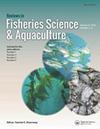Ontogenetic Changes in Dispersal and Habitat Use in Hatchery-Reared Lingcod
引用次数: 2
Abstract
Preliminary experiments that optimize release methods pave the way to larger-scale releases and proper evaluation methods. One evaluation method is before-after-control-impact, which requires that more animals remain at release areas (“site fidelity” to impact areas) than disperse to control areas. This study tested whether there are release methods that maximize fidelity to the release area and minimize dispersal to nearby areas, which might enable a before-after-control-impact experiment. Lingcod that were 17-months old at release showed greater fidelity to release areas (23% remaining one year after release) than lingcod that were 9- and 11-months old at release. None of the 17- and 21-month-old release groups were detected on more distant structured habitats 44 weeks after release, but 8% and 13% of lingcod from the 9- and 11-month-old release groups were detected at distant structured habitat. Thus, releasing 17-month-old lingcod maximized fidelity to the release area and minimized dispersal to other areas. Differences in fidelity and dispersal rates among release-age groups may reflect ontogenetic changes in dispersal and habitat use patterns that have also been reported for wild lingcod. These behavioral similarities with wild lingcod also suggest that hatchery lingcod have potential to interact and integrate with wild lingcod in nature.孵化场饲养银鳕种群扩散和生境利用的个体发生变化
优化释放方法的初步实验为更大规模的释放和合理的评价方法奠定了基础。一种评估方法是控制影响之前-之后,它要求更多的动物留在释放区域(对影响区域的“现场保真度”),而不是分散到控制区域。本研究测试了是否有释放方法可以最大限度地保证释放区域的保真度,并最大限度地减少对附近区域的扩散,从而可以进行前后控制影响实验。17个月大的灵鳕鱼比9个月和11个月大的灵鳕鱼对释放区域的保真度更高(23%)。在放生44周后,17个月和21个月大的放生组在更远的结构化栖息地都没有被检测到,但在9个月和11个月大的放生组中,8%和13%的放生组在更远的结构化栖息地被检测到。因此,放生17个月大的陵鳕可以最大限度地保证放生区域的保真度,并最大限度地减少向其他区域的扩散。放生年龄组之间保真度和扩散率的差异可能反映了野生灵鳕鱼在扩散和栖息地利用模式方面的个体发生变化。这些与野生灵鳕鱼行为上的相似性也表明孵化场灵鳕鱼有可能与自然界中的野生灵鳕鱼相互作用和融合。
本文章由计算机程序翻译,如有差异,请以英文原文为准。
求助全文
约1分钟内获得全文
求助全文

 求助内容:
求助内容: 应助结果提醒方式:
应助结果提醒方式:


